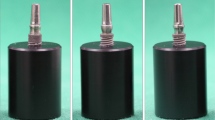Abstract
A mini implant system made from Ti-6Al-4V alloy was used as the experimental material. The pull-out strength between the implant fixture and abutment was evaluated after the implant fixture and tapered abutment had been fixed by static compression loading, and hit with a mallet. Moreover, the fatigue limit was evaluated based on ISO/FDIS 14801:2003(E). In cases with compressive loading of 10, 50, 100, 150 and 200 N, the measured full-out load was 17.1 N, 33.6 N, 86.9 N, 99.7 N and 157.6 N, respectively. The full-out load measurements were 139.1 N and 195.6 N in the case of the mallet weight of 70 and 130 g, respectively (P < 0.05). The measured pull-out strength increased with increasing weight and number of mallet strokes, and the compression load. The compressive strength was examined according to the implant angle. The compressive strength in the 30° group was 532.2 ± 56.7 N, which was the highest value. On the other hand, the compressive strength in the 60° and 90° group was 156.7 ± 12.6 N and 117.3 ± 6.0 N, respectively. The fatigue life increased with decreasing applied strength level and the fatigue limit was 240 N.
Similar content being viewed by others
References
Binon, P. P., “Evaluation of matching accuracy and consistency of selected implant, standard abutments, and laboratory analog,” The International Journal of Prosthodontics, Vol. 8, No. 2, pp. 162–178, 1995.
Binon, P. P., “The effect of implant/abutment hexagonal misfit on screw joint stability,” The International Journal of Prosthodontics, Vol. 9, No. 2, pp. 149–152, 1996.
Kim, H. J., Chu, J. U., Han, S. M., Choi, K. W., Yoo, J. H., and Youn, I. C., “Study of optimized hip implant development for hip implant in total hip replacement,” Int. J. Precis. Eng. Manuf., Vol. 12, No. 4, pp. 719–725, 2011.
Burguete, R. I., Johns, R. B., King, T., and Patterson, E. A., “Tightening characteristics for screw joints in osseointegrated dental implants,” The Journal of Prosthetic Dentistry, Vol. 71, No. 6, pp. 592–599, 1994.
Sutter, F., Weber, H. P., Sorensen, J., and Belser, U., “The new restorative concept of the ITI dental implant system: design and engineering,” International Journal of Periodontics & Restorative Dentistry, Vol. 13, No. 5, pp. 409–431, 1993.
Lang, L. A., May, K. B., and Wang, R. F., “The effect of the use of a counter torque device on the abutment-implant complex,” The Journal of Prosthetic Dentistry, Vol. 81, No. 4, pp. 411–417, 1999.
Korioth, T. W. P., Cardoso, A. C., and Versluis, A., “Effect of washers on reverse torque displacement of dental implant gold retaining screws,” The Journal of Prosthetic Dentistry, Vol. 82, No. 3, pp. 312–316, 1999.
Müftü, A. and Chapman, R. J., “Replacing posterior teeth with freestanding implants: four-year prosthodontic results of a prospective study,” Journal of the American Dental Association, Vol. 129, No. 8, pp. 1097–1102, 1998.
Shatkin, T. E., Shatkin, S., Oppenheimer, A. J., and Oppenheimer, B. D., “A simplified approach to implant dentistry with mini dental implants,” The Alpha Omegan, Vol. 96, No. 3, pp. 7–15, 2003.
Froum, S., Emtiaz, S., Bloom, M. J., Scolnick, J., and Tarnow, D. P., “The use of transitional implants for immediate fixed temporary prostheses in cases of implant restorations,” Practical periodontics and aesthetic dentistry, Vol. 10, No. 6, pp. 737–746, 1998.
Bozkaya, D. and Müftü, S., “Mechanics of the tapered integrated screwed-in (TIS) abutments used in dental implants,” Journal of Biomechanics, Vol. 38, No. 1, pp. 87–97, 2005.
Bozkaya, D. and Müftü, S., “Mechanics of the tapered interference fit in dental implants,” Journal of Biomechanics, Vol. 36, No. 11, pp. 1649–1658, 2003.
Zarb, H. A. and Schmitt, A., “The longitudinal clinical effectiveness of osseointegrated dental implants: The Toronto study. Part III: Problems and complications encountered,” The Journal of Prosthetic Dentistry, Vol. 64, No. 2, pp. 185–194, 1990.
Balfour, A. and O’Brien, G. R., “Comparative study of antirotational single tooth abutments,” The Journal of Prosthetic Dentistry, Vol. 73, No. 1, pp. 36–43, 1995.
Boggan, R. S., Strong, J. T., Misch, C. E., and Bidez, M. W., “Influence of hex geometry and prosthetic table width on static and fatigue strength of dental implants,” The Journal of Prosthetic Dentistry, Vol. 82, No. 4, pp. 436–440, 1999.
Author information
Authors and Affiliations
Corresponding author
Rights and permissions
About this article
Cite this article
Park, IS., Lee, KS., Shin, GS. et al. Mechanical properties of Ti-6Al-4V alloy mini-implant system. Int. J. Precis. Eng. Manuf. 14, 1601–1605 (2013). https://doi.org/10.1007/s12541-013-0216-6
Received:
Accepted:
Published:
Issue Date:
DOI: https://doi.org/10.1007/s12541-013-0216-6




